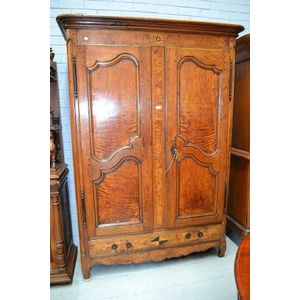George III Oak Housekeeper's Cupboard with Drawers and Shelves
A good George III oak housekeeper's cupboard, the top with two double panelled doors flanking a fixed conforming section, opening to reveal three shelves, the base with a combination of four short drawers and a small single panelled door cupboard, raised on bracket feet, brass H-form hinges, good colour and patina. 166 cm x 50.5 cm x 208 cm
You must be a subscriber, and be logged in to view price and dealer details.
Subscribe Now to view actual auction price for this item
When you subscribe, you have the option of setting the currency in which to display prices to $Au, $US, $NZ or Stg.
This item has been sold, and the description, image and price are for reference purposes only.
- Oak - Native to Europe and England, oak has been used for joinery, furniture and building since the beginning of the medieval civilisation. It is a pale yellow in colour when freshly cut and darkens with age to a mid brown colour.
Oak as a furniture timber was superceded by walnut in the 17th century, and in the 18th century by mahogany,
Semi-fossilised bog oak is black in colour, and is found in peat bogs where the trees have fallen and been preserved from decay by the bog. It is used for jewellery and small carved trinkets.
Pollard oak is taken from an oak that has been regularly pollarded, that is the upper branches have been removed at the top of the trunk, result that new branches would appear, and over time the top would become ball-like. . When harvested and sawn, the timber displays a continuous surface of knotty circles. The timber was scarce and expensive and was used in more expensive pieces of furniture in the Regency and Victorian periods. - George Iii - George III (1738 - 1820) was King of Great Britain and Ireland from 1760 to 1820.
- Bracket Feet - On bracket feet the corner edge is square and joined by a mitre to its partner on the opposite angle. The inner edge is usually shaped or scalloped. Bracket feet were first introduced in the early 18th century and used until c. 1830 and are found on carcase furniture such as chests, cabinets, bookcases and bureaux.
Ogee bracket feet, a variation on straight bracket feet, have the outside edge forming an "S" shaped curve with the top bulging outward and the bottom turning inward.
On splayed bracket feet, the exterior edge curves outward. - Patination / Patina - In broad terms, patination refers to the exterior surface appearance of the timber, the effect of fading caused by exposure to sunlight and air over the course of a century or more, changing the piece to a soft, mellow colour.
As patina is very difficult to replicate, it is one of the most important guides to determining the age of furniture.
Patina is also the term applied to the bloom or film found on old bronzes due to oxidisation.
This item has been included into following indexes:
Visually similar items

Antique late 18th century French two door armoire, approx. 209 cm high, 135 cm wide
Sold by
in
for
You can display prices in $Au, $US, $NZ or Stg.

Antique 18th century French oak two piece buffet, with four doors, approx 167 cm high, 134 cm wide
Sold by
in
for
You can display prices in $Au, $US, $NZ or Stg.

19th century mahogany inlaid gentleman's press with two door top & three drawer base on turned legs
Sold by
in
for
You can display prices in $Au, $US, $NZ or Stg.

Press. 19th century mahogany & fruitwood inlaid decorated two door four drawer
Sold by
in
for
You can display prices in $Au, $US, $NZ or Stg.
